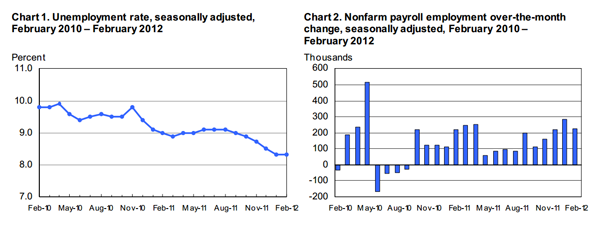According to the Labor Department, the U.S. economy added
227,000 jobs in February, the third month in a row of job gains in
excess of 200,000 positions. Unemployment remained at 8.3 percent,
its lowest point since early 2009. Revisions to previous months
showed that January added 41,000 more jobs than previously reported
and December added 20,000 more.
Growth was concentrated in the services sector, however, there
was meaningful growth in important segments of manufacturing –
including machinery, fabricated metals, and transportation
equipment – all three harbingers of a manufacturing economy
spinning up. In the services sector, the only significant loss was
of 35,000 positions from general merchandise stores, though it was
likely a continuation of the ramp down from holiday hiring, rather
than a sign of changing tides for retail.

Professional and business services were responsible for more
than a third of all job growth in February, with growth in
accounting and bookkeeping services (7,300), architectural and
engineering services (4,300), computer system design services
(10,200), and managing and consulting services (7,400). Healthcare
services accounted for more than a quarter (61,100) of jobs
produced during the month. Lastly, food services and drinking
places added more than 40,000 positions as workers with a bit more
disposable income and more confidence in the stability of that
income have begun to go out to eat and drink a bit more.
On an education level-basis, new positions created were
exclusively being filled by those with 4-year degrees and up. The
total number of employees holding a 4-year degree or higher rose by
more than 380,000 during the month. The professional and managerial
unemployment rate fell from 4.9 to 4.2 percent year-over-year.
Unfortunately for trend spotters, February, March, and April of
2011 also saw 200,000+ job growth before decelerating during the
summer months. The reasons blamed for job growth falling – such as
rising gas prices, a European debt crisis, and Middle East
instabilities – all remain on the horizon. Yet, this round of job
reports adding in excess of 200,000 at a time started two months
earlier than last time around, and is being met more strongly with
rising consumer confidence.
While the trend may seem similar to the one that fizzled a year
earlier, it may also be just positive enough to have reached an
“escape velocity,” as Patrick O’Keefe, the director of economic
research at consulting firm J. H. Cohn, characterized it to
The New York Times. Enough jobs are being created
to add enough consumers to the market to necessitate more employees
be hired

 Login
Login